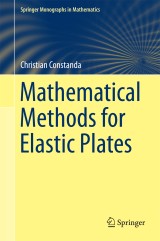Details

Mathematical Methods for Elastic Plates
Springer Monographs in Mathematics
|
53,49 € |
|
| Verlag: | Springer |
| Format: | |
| Veröffentl.: | 24.06.2014 |
| ISBN/EAN: | 9781447164340 |
| Sprache: | englisch |
Dieses eBook enthält ein Wasserzeichen.
Beschreibungen
<p>Mathematical models of deformation of elastic plates are used by applied mathematicians and engineers in connection with a wide range of practical applications, from microchip production to the construction of skyscrapers and aircraft. This book employs two important analytic techniques to solve the fundamental boundary value problems for the theory of plates with transverse shear deformation, which offers a more complete picture of the physical process of bending than Kirchhoff’s classical one.</p><p>The first method transfers the ellipticity of the governing system to the boundary, leading to singular integral equations on the contour of the domain. These equations, established on the basis of the properties of suitable layer potentials, are then solved in spaces of smooth (Hölder continuous and Hölder continuously differentiable) functions.</p><p>The second technique rewrites the differential system in terms of complex variables and fully integrates it, expressing the solution as a combination of complex analytic potentials.</p><p>The last chapter develops a generalized Fourier series method closely connected with the structure of the system, which can be used to compute approximate solutions. The numerical results generated as an illustration for the interior Dirichlet problem are accompanied by remarks regarding the efficiency and accuracy of the procedure.</p><p>The presentation of the material is detailed and self-contained, making <i>Mathematical Methods for Elastic Plates</i> accessible to researchers and graduate students with a basic knowledge of advanced calculus.</p>
Singular Kernels.- Potentials and Boundary Integral Equations.- Bending of Elastic Plates.- The Layer Potentials.- The Newtonian Potential.- Existence of Regular Solutions.- Complex Variable Treatment.- Generalized Fourier Series.
Christian Constanda, BS, PhD, DSc, is the Charles W. Oliphant Professor of Mathematical Sciences at the University of Tulsa, USA, Emeritus Professor of Mathematics at the University of Strathclyde, UK, and Chairman of the International Consortium on Integral Methods in Science and Engineering. He has authored, edited, and translated 25 mathematical books and has published over 135 research papers in scholarly journals.
Mathematical models of deformation of elastic plates are used by applied mathematicians and engineers in connection with a wide range of practical applications, from microchip production to the construction of skyscrapers and aircraft. This book employs two important analytic techniques to solve the fundamental boundary value problems for the theory of plates with transverse shear deformation, which offers a more complete picture of the physical process of bending than Kirchhoff’s classical one.<br> <br>The first method transfers the ellipticity of the governing system to the boundary, leading to singular integral equations on the contour of the domain. These equations, established on the basis of the properties of suitable layer potentials, are then solved in spaces of smooth (Hölder continuous and Hölder continuously differentiable) functions.<br> <br>The second technique rewrites the differential system in terms of complex variables and fully integrates it, expressing the solution as a combination of complex analytic potentials.<br> <br>The last chapter develops a generalized Fourier series method closely connected with the structure of the system, which can be used to compute approximate solutions. The numerical results generated as an illustration for the interior Dirichlet problem are accompanied by remarks regarding the efficiency and accuracy of the procedure.<br> <br>The presentation of the material is detailed and self-contained, making <i>Mathematical Methods for Elastic Plates</i> accessible to researchers and graduate students with a basic knowledge of advanced calculus.
Provides a rigorous mathematical analysis of the model of bending of plates with transverse shear deformation Illustrates the boundary integral equation method through a specific application Constructs closed form (in terms of both real and complex variables) solutions that are suitable for numerical approximations Includes supplementary material: sn.pub/extras
Diese Produkte könnten Sie auch interessieren:

Introduction to Hamiltonian Dynamical Systems and the N-Body Problem

von: Kenneth Meyer, Glen Hall, Dan Offin

106,99 €















